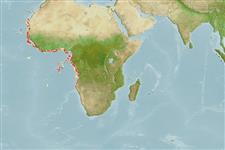Environment: milieu / climate zone / depth range / distribution range
Ecologie
marien bathydemersaal; standvastig; diepte 366 - 1620 m (Ref. 1371), usually 500 - 600 m (Ref. 1371). Deep-water; 24°N - 17°S, 22°W - 13°E (Ref. 1371)
Eastern Central Atlantic: Western Sahara south to Angola.
Grootte / Gewicht / Leeftijd
Maturity: Lm ? range ? - ? cm
Max length : 34.0 cm TL mannelijk / geslacht onbekend; (Ref. 1371)
Dorsale stekels (totaal): 2; Dorsale zachte stralen (totaal): 140-141. Head large; eyes also large; snout short, narrow, bluntly acute, with a small bifid scute at its tip. Head completely scaled except for underside of snout. Body tapering to a point posteriorly from behind the origin of the first dorsal fin base. Pyloric caeca 20. Spinules on scales broad, shield-shaped. Overall color is brownish to swarthy; trunk bluish to violet; fins blackish; mouth and gill cavities gray to blackish.
Specimens from northwestern Africa feed primarily on faunal organisms, especially polychaetes (90% of contents) and a variety of small crustaceans. Smaller individuals (30-40 mm head length) feed mostly on epibenthic organisms, especially the copepod Aetidopsis carinata (Ref. 6219).
Levenscyclus en paargedrag
Maturiteit | Voortplanting | Paaien | Eieren | Fecunditeit | Larven
Cohen, D.M., T. Inada, T. Iwamoto and N. Scialabba, 1990. FAO species catalogue. Vol. 10. Gadiform fishes of the world (Order Gadiformes). An annotated and illustrated catalogue of cods, hakes, grenadiers and other gadiform fishes known to date. FAO Fish. Synop. 125(10). Rome: FAO. 442 p. (Ref. 1371)
Status op de Rode Lijst van het IUCN (Ref. 130435)
Gevaar voor de mens
Harmless
Gebruik door de mens
Meer informatie
Lokale namenSynoniemenMetabolismePredatorenEcotoxicologieVoortplantingMaturiteitPaaienPaaiaggregatiesFecunditeitEierenOntwikkeling van de eieren
Leeftijd/GrootteGroeiLengte-gewichtLengte-lengteLengtefrequentiesMorfometrieMorfologieLarvenLarvale populatiedynamiekRekruteringAbundantieBRUVS
ReferentiesAquacultuurAquacultuurprofielKweeklijnenGeneticaElectrophoresesErfelijkheidZiektesVerwerkingNutrientsMassaconversie
Tools
Speciale rapporten
Download XML
Internetbronnen
Estimates based on models
Preferred temperature (Ref.
123201): 6.2 - 8.7, mean 6.8 °C (based on 8 cells).
Fylogenetische diversiteitsindex (Ref.
82804): PD
50 = 0.5000 [Uniqueness, from 0.5 = low to 2.0 = high].
Bayesian length-weight: a=0.00219 (0.00111 - 0.00431), b=3.20 (3.03 - 3.37), in cm total length, based on LWR estimates for this (Sub)family-body shape (Ref.
93245).
Trofisch niveau (Ref.
69278): 3.2 ±0.31 se; based on food items.
Weerstandsvermogen (Ref.
120179): laag, minimale populatieverdubbelingstijd 4,5-14 jaar (Preliminary K or Fecundity.).
Fishing Vulnerability (Ref.
59153): Low vulnerability (24 of 100).
